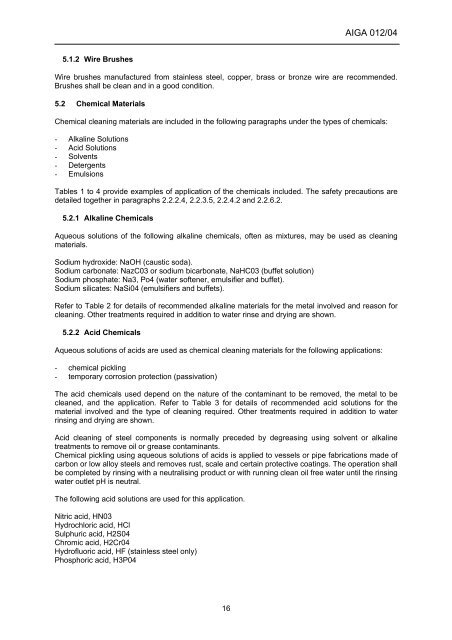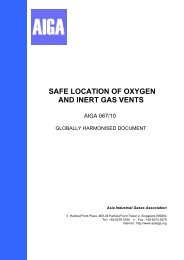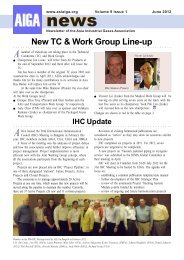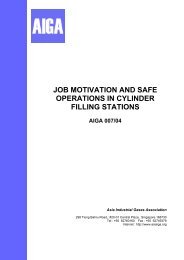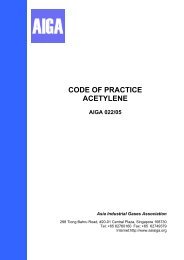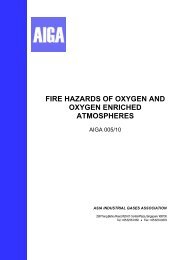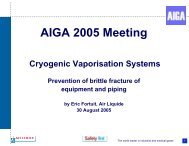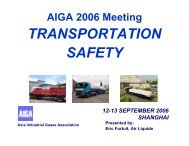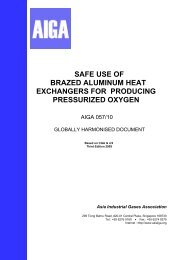CLEANING OF EQUIPMENT FOR OXYGEN SERVICE - AIGA
CLEANING OF EQUIPMENT FOR OXYGEN SERVICE - AIGA
CLEANING OF EQUIPMENT FOR OXYGEN SERVICE - AIGA
You also want an ePaper? Increase the reach of your titles
YUMPU automatically turns print PDFs into web optimized ePapers that Google loves.
5.1.2 Wire Brushes<br />
16<br />
<strong>AIGA</strong> 012/04<br />
Wire brushes manufactured from stainless steel, copper, brass or bronze wire are recommended.<br />
Brushes shall be clean and in a good condition.<br />
5.2 Chemical Materials<br />
Chemical cleaning materials are included in the following paragraphs under the types of chemicals:<br />
- Alkaline Solutions<br />
- Acid Solutions<br />
- Solvents<br />
- Detergents<br />
- Emulsions<br />
Tables 1 to 4 provide examples of application of the chemicals included. The safety precautions are<br />
detailed together in paragraphs 2.2.2.4, 2.2.3.5, 2.2.4.2 and 2.2.6.2.<br />
5.2.1 Alkaline Chemicals<br />
Aqueous solutions of the following alkaline chemicals, often as mixtures, may be used as cleaning<br />
materials.<br />
Sodium hydroxide: NaOH (caustic soda).<br />
Sodium carbonate: NazC03 or sodium bicarbonate, NaHC03 (buffet solution)<br />
Sodium phosphate: Na3, Po4 (water softener, emulsifier and buffet).<br />
Sodium silicates: NaSi04 (emulsifiers and buffets).<br />
Refer to Table 2 for details of recommended alkaline materials for the metal involved and reason for<br />
cleaning. Other treatments required in addition to water rinse and drying are shown.<br />
5.2.2 Acid Chemicals<br />
Aqueous solutions of acids are used as chemical cleaning materials for the following applications:<br />
- chemical pickling<br />
- temporary corrosion protection (passivation)<br />
The acid chemicals used depend on the nature of the contaminant to be removed, the metal to be<br />
cleaned, and the application. Refer to Table 3 for details of recommended acid solutions for the<br />
material involved and the type of cleaning required. Other treatments required in addition to water<br />
rinsing and drying are shown.<br />
Acid cleaning of steel components is normally preceded by degreasing using solvent or alkaline<br />
treatments to remove oil or grease contaminants.<br />
Chemical pickling using aqueous solutions of acids is applied to vessels or pipe fabrications made of<br />
carbon or low alloy steels and removes rust, scale and certain protective coatings. The operation shall<br />
be completed by rinsing with a neutralising product or with running clean oil free water until the rinsing<br />
water outlet pH is neutral.<br />
The following acid solutions are used for this application.<br />
Nitric acid, HN03<br />
Hydrochloric acid, HCl<br />
Sulphuric acid, H2S04<br />
Chromic acid, H2Cr04<br />
Hydrofluoric acid, HF (stainless steel only)<br />
Phosphoric acid, H3P04


